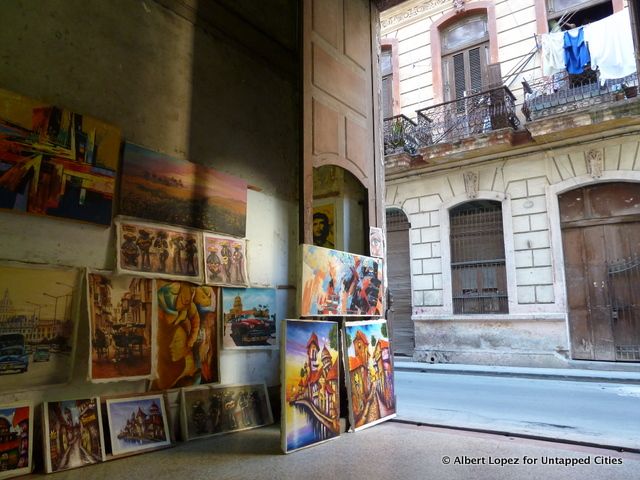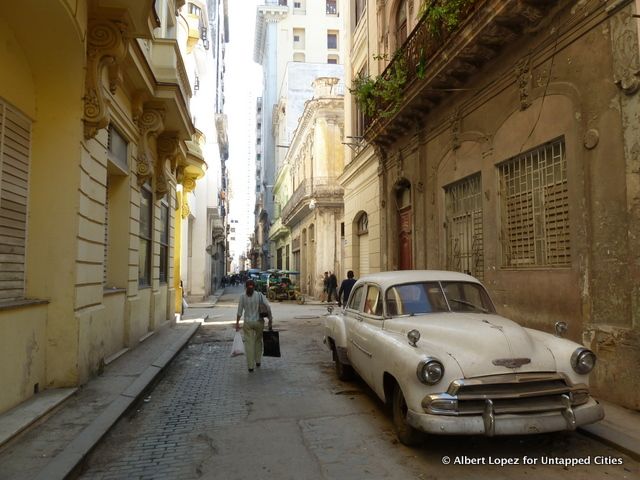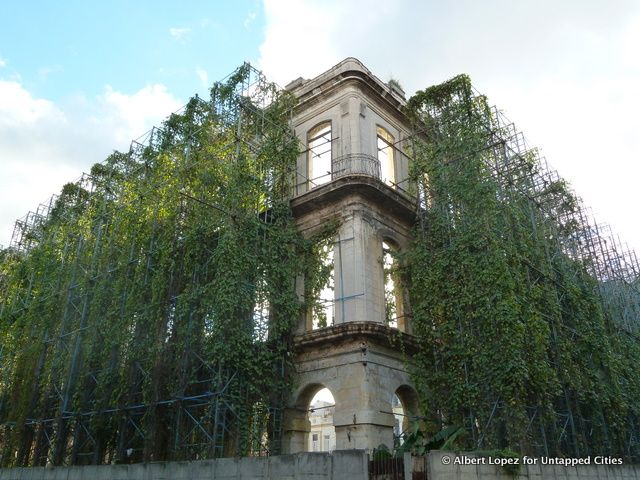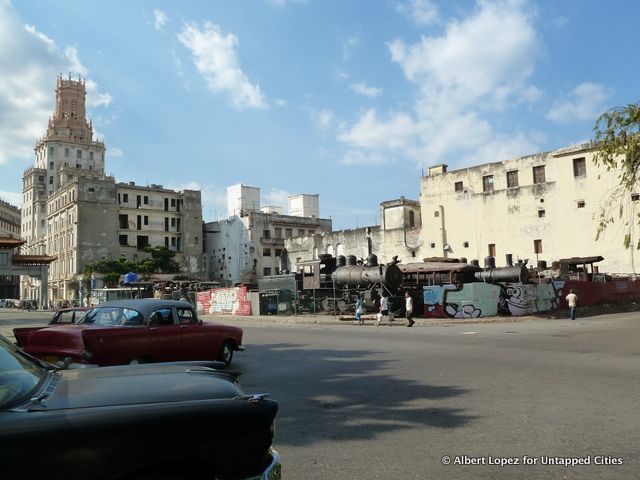Last-Minute NYC Holiday Gift Guide 🎁
We’ve created a holiday gift guide with presents for the intrepid New Yorker that should arrive just in time—



By the time I was born, Cuba for my family had evolved into an elaborate fairytale, replete with its castles, heroes and monsters. I suppose that with its chief antagonist perpetually clad in green, the mythical land even had its dragon. With only 27 years having passed since their departure and my birth, the grudges were still very much alive and the scars fresh – these things tend to persist longer than normal according to Cuban tradition.
I had assumed that it was out of political stubbornness that nobody had returned, though with the incessant storytelling every evening over coffee (which I am now grateful for) and the walls plastered with images that had been taken in a long-since disappeared studio on Calle O’Reilly, I realize that it was because in some ways, they had never really left (a fact confirmed one afternoon when my grandmother, in one of her “senior moments” went to the front door to call the name of a next door neighbor that they had back in Cuba). For them, to physically return to Cuba was to return to another dimension, a false Cuba, a land of ghosts and shadows (her phone book was filled with all of the old addresses, with their names crossed out and corrected either with their new addresses in the U.S. or the date that they died and the all too familiar acronym E.P.D.)
When I finally boarded that Havana-bound flight from Los Angeles, I was filled with the anxiety, fear, and delusional desire that had not only accumulated in my own 25 years, but had also built up in each and every other member of my family, both living and dead. Upon arrival onto the tarmac at Jose Marti International Airport, I had in effect become nostalgia’s young ambassador to the uncanny.
The Cuba that I found, and that you will find if you travel there, is in fact like all the travel guides and TV specials say – a time warp that brings the visitor to the 1950s. More disturbingly, it had become a sort of mirror image of the Cuba that my family had taken with them. The eclectic facades were bent, folded, and faded just like the photos that had been kept in the box in my grandmother’s dresser. It was a massive antiquarium, like the house of mementos belonging to those who held onto their identities as exiles. There was a sort of continuity that linked these two images of Cuba, yet I was sure, just as I had been in my grandmother’s house, that they were both distortions.
We must recall that the apparent moment in the past that Havana returns us to is not to be taken seriously. Though the American cars remained and the massive placards pronouncing “Hasta la Victoria Siempre” or “Venceremos” still cover walls or line the roads, they are merely the fetishes of two historical moments that have long since passed, but which for the lack of money have failed to be replaced or painted over. Yet they, along with the image of the collapsed colonial edifice, persist, even more so than the Royal Palm or the Virgin of El Cobre, as the icons of Cuba. Perhaps it is their photogenic composition, a quality that seems to always be enhanced with the diversity that decay lends it, which makes them so frequently portrayed and reproduced. Whatever the cause, I will admit that some of the photographs that I took, and that are displayed in this article fall more or less into that category of coffee table book images that seemed to flood the public sphere around the same time that Ry Cooder “discovered” Cuban Son.

That all-too familiar and often stereotyped image of Cuba has become a major cornerstone in what is becoming a lucrative market for historotourism – a curious creation that prompts the average adventurer to think that he or she has become a time-traveler – big bucks in a world where everybody thinks of themselves as an amateur historian. Big bucks, too in an age when many of the generation that left Cuba in the beginning years of the revolution are pushing their 60s and may be finally tempted with the prospect of returning, if just for a moment, to the land of their childhood (I was surprised to see four different flights connecting Miami to Havana the day that I left – by now, I’m beginning to wonder who in Dade county hasn’t spent at least a weekend in Cuba)
The relics of the past have unsurprisingly been trademarked, or at least incorporated into that curious semi-private institution that seems to manage the entire historical core of Havana. Habaguanex S.A., the group responsible, under the direction of city historian Eusebio Leal Spengler, for the restoration and preservation work of the city, has turned this historical experience into the economic engine for Old Havana, using funds for the restoration of the protected areas of the old city (which more often than not tend to be areas of high tourist traffic rather than actual residential quarters.) The four plazas of the colonial city (Vieja, Armas, San Francisco, and La Catedral ) are in remarkably fresh condition (I must remind you, that they only form a small fraction of the Cuban metropolis’s urban area, and only one of its 15 districts) and the image of the “city of columns” has been resuscitated to form the colorful interface that most tourists see in the institutionalized portions of the city.

This institutionalization of the colonial city is only one way in which Havana’s nostalgia tour has been absorbed into Cuban equivalent of “big business.” Perhaps the coup de grâce for the “official” Havana experience came with the institutionalizing of the cars under GranCar, where officially licensed vehicles can take you around the city. They form a minority of Havana’s old car stock, I assure you, but they tend to have the cars with the best paint jobs and original parts. They are driven by a lucky lot of Cubans whose spotless attire, all white shoes, and wide brimmed panama hats testify to their membership of a rapidly growing nouveau riche, whose connections and access to tourist dollars have made them more fortunate than the other drivers throughout the city. All of this has lamentably added up to a Havana that in many ways is profoundly “tapped.”
When I had returned to Cuba (I admit that this is misleading since I had never set foot on the island prior to this trip, but for any Cuban born in exile, going to Cuba is always a “return” ) I had expected nostalgia – in fact I had come specifically for the nostalgia as a way of healing the wounds of the past. However, what I found in all too many places were caricatures of the Cuban citizen and elaborate mise-en-scà ¨nes that had a habit of following groups of German, Italian, or English speaking tourists. In costume, they wore overdone rumbero outfits that appeared to have been sewn for the massive carnival of 1962. In the middle of January, every day was carnival – rumba, conga, and comparsa hasta la médula! I had expected nostalgia, but after a few days, I had enough. I had to get out of Disneyland, so I walked.
I walked, and walked, and walked”¦and I’ll advise this mode of action to any traveler who goes there – get lost. Mind you, it’s best to do this during the day since most of the streets are barely lit at night, but wander off the path – save for the jineteras, most Cubans don’t bite. But some of them do hustle, more frequently but less aggressively in the historic core and the reverse as soon as one leaves the UNESCO heritage site along the borders of Calle Bélgica or the Paseo del Prado. After leaving that rough frontier, one is fairly free to walk or ride up the main arteries that cut through Central Havana and El Vedado with little hassle.

Why the hustling”¦the repeated calls of “Hello my friend”¦American?” How did they know I was American, and with the embargo supposedly still in effect, why was that their first guess? It’s the effects of a rapidly changing economy. With the Cuban government having cut over a half million state jobs starting in 2010 and the beginning of a process of granting business licenses to numerous eager Cubans, the streets of Havana have become a bit of a free-for-all. Everybody wants to get into the tourist trade, to cash in on the historotourism, gastrotourism, agrotourism”¦an almost surprisingly illegal sex-tourism. I was hit by this in what seemed to be a fifteen minute conversation with a guy walking down the Prado. It’s always best, when you’re a tourist, to say “no, gracias,” but for me it was next to impossible – I enjoy talking to people, perhaps too much. He said, “I’m going to show you the bar where Buena Vista Social Club used to play and drink at before they were famous.” (If you go to Havana, you will hear this a lot, prompting me to believe that either these would-be tour guides are all liars or the musicians of that group were the biggest drinkers of all time). We went, and of course he expected a mojito – which he claimed were the best in town. This happened again, and I had enough, but was willing to thank the guy anyways for showing me a neat bar. Next he wanted to show me the roof top gardens above the decrepit solar that he lived in with his family – I agreed, and indeed it was impressive. It was a vegetable garden alongside the neighborhood weight lifting club, with an incredible view of the city. He was proud to show off the roof, to demonstrate “How real Cubans live.” He had hit all the right notes for the young North American tourist – show off what’s vintage or what has “history,” offer good food and alcohol at a locals only joint, and reveal to them how the poor really live. History, food, and showcasing the slums ”¦wait for it, wait for it”¦” Do you want to go out dancing with my niece? Es una linda mulata!”
That, ladies and gentlemen, is an aspect of untapped Cuba – thousands of Cubans wanting to have access to Cuban Convertible Pesos (CUC’s) and doing anything possible to get into that economy. When you realize that they make on average 20-30 CUC’s a month (in Cuban National Currency, mind you, not Tourist CUC’s) and that the soaring cost of living and diminishing government rations is making those wages impossible to survive on, the need to create a business aimed at non-Cubans is for many becoming a matter of survival. This became all too clear when I had hired a driver who lived in the non-tourist area of El Cerro. With a newborn baby and his wife out of work, the dollars he was getting from me ensured that he could keep his car running and his child fed. He didn’t have a flashy Chevrolet, Buick, or Desoto – he had a beat up 1990 Fiat that was the most prized member of the family. Not the kind of car that the tourist wants to go around in, perhaps? But the kind of car that most Cubans not already tied into the tourist trade are driving, which puts him and his family at a disadvantage. He mainly drives locals, making 1/20th of what he could make on a foreigner. When I hired him, he told me “ ¡Albert, tu eres mi Santiclaus!”
I soon realized that the excessive nostalgia that I and many others had come back for was on one hand driving a relatively healthy emerging tourist economy, but it was also supporting a hopelessly unsustainable image that not everybody has access to. It reminded me of the graffiti that I saw in Venice that said, critically “Sostenando un ideal” – Sustaining an ideal. Though it’s an extreme case, who goes to Venice for its actual inhabitants (who actually live on the mainland)? You go there to enjoy the picturesque piazzas, the high-end glass shops, and the gondola ride around the islands that are too expensive for most people to live in. This has yet to happen in Havana, but one can only wonder what will happen in the future now that Cubans can buy and sell property, effectively creating a real housing market (at the time of my visit, I was informed through la bola that a group of Harvard real-estate students were in the city).
When compared to the rest of the Cuban Metropolis, relatively few people live in the dense quarters of Old Havana. However, with a quick glance of their housing stock, it is evident that they are currently some of the poorest of the city’s inhabitants, and perhaps the most welcome recipients of tourist dollars. With their location now being advantageous, however, they may be some of the first to reap the success of an opening economy geared toward tourism. But what of the others who are trying to open up restaurants in La Habana del Este, Regla, or Rancho Boyeros? How will they get tourist dollars to remain afloat? How will they compete with the more attractive tourist centers whose government restaurants are full at every hour, or whose well located private paladares are effectively cornering the market? If our readership is truly interested in seeking the untapped of Havana, it will take some courage and some exploring to seek the hidden businessmen, eager to enter the tourist economy to make their living better.
Subscribe to our newsletter